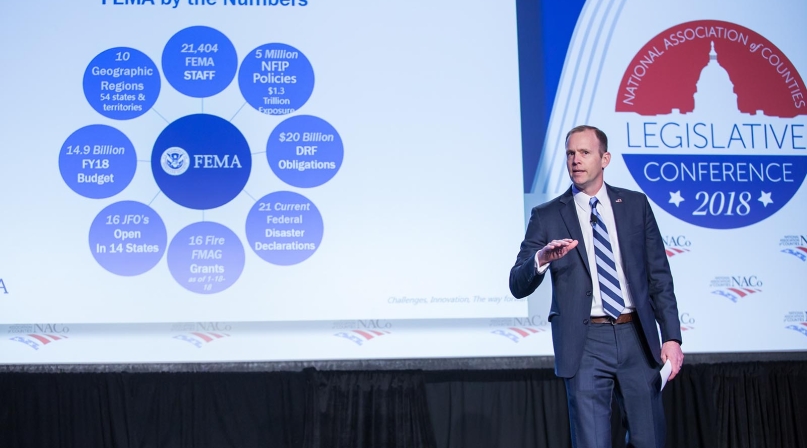FEMA hopes to embed staff in local communities

Long: "All disasters begin and end at the local level"
The head of the Federal Emergency Management Agency (FEMA) wants to get FEMA staff out of federal and regional offices and embedded in states, large cities and eventually local communities, FEMA Administrator William “Brock” Long told NACo members March 6.
“We’re going to help you with planning, mitigation and public outreach,” Long said. “We’re going to start changing. I want the relationship now rather than when disaster strikes.” Long made his comments at the Opening General Session.
“My goal is to help support you in achieving your goals,” he said, “not dictating what your goals should be.”
Long noted that in his 17 years in emergency management, there are three things he’s learned:
“First, all disasters begin and end at the local level.”
“Two, I don’t care who you are, I don’t care what your politics are…when a disaster strikes, it requires all of us, we’re all in it together to be able to help our citizens respond and recover.”
“The third thing I’ve learned is every time I change jobs, something catastrophic happens.”
After the hurricanes that hit Texas, Louisiana and Florida “we learned as a result of 2017, Mother Nature does not seem to recognize the flood maps that we produce,” Long said.
“We’ve gotten away from the very simple fact that any house can flood, regardless if you’re on the map or not. I’m kind of tired of the argument that these maps needing to be changed.”
“Quite frankly the NFIP program is not operating on a functional sound basis,” he said. “We need Congress to change the platform on which we operate. We need to double the number of policyholders from 5 million to 10 million.”
Physically inspecting damaged homes, Long said, is an “antiquated” way of doing things and “slows things down.” He said he hopes to start using technology.
“It’s a delicate balance,” he noted, because he has to protect against fraud but said for the most part, “the overwhelming majority are honestly seeking assistance after suffering damage.”
Long also advised county officials to “get to know your local emergency manager” and “make sure they are properly staffed and properly funded.”
Resiliency is at the local level, Long noted. “Land use planning and building codes can create resiliency and reduce the risk. I need you to help me overcome that.”
Attachments
Related News

County Countdown – January 28, 2025
Every other week, NACo's County Countdown reviews top federal policy advocacy items with an eye towards counties and the intergovernmental partnership.

Los Angeles County aims to recover and rebuild after historic wildfires
Over a week after a series of deadly fires sparked across Los Angeles County, at least 25 people are dead, thousands of structures, including businesses and homes, have been destroyed and roughly 100,000 people across the county have been displaced.

County leaders look at adapting to ever-changing disaster risks
State associations of counties and their staff can serve a vital role in providing support, experience to counties facing disasters.
